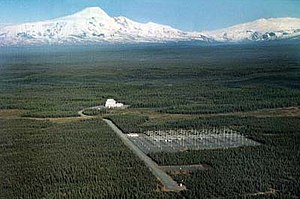 | |
| Established | 1993 |
|---|---|
Field of research | Ionosphere |
| Location | Gakona, Alaska, United States |
Operating agency | University of Alaska Fairbanks |
| Website | https://haarp.gi.alaska.edu/ |
The High-frequency Active Auroral Research Program (HAARP) is a University of Alaska Fairbanks program which researches the ionosphere – the highest, ionized part of Earth's atmosphere. The most prominent instrument at HAARP is the Ionospheric Research Instrument (IRI), a high-power radio frequency transmitter facility operating in the high frequency (HF) band. The IRI is used to temporarily excite a limited area of the ionosphere. Other instruments, such as a VHF and a UHF radar, a fluxgate magnetometer, a digisonde (an ionospheric sounding device), and an induction magnetometer, are used to study the physical processes that occur in the excited region. Work on the HAARP facility began in 1993. Initially HAARP was jointly funded by the U.S. Air Force, the U.S. Navy, the University of Alaska Fairbanks, and the Defense Advanced Research Projects Agency (DARPA).[1] It was designed and built by BAE Advanced Technologies. Its original purpose was to analyze the ionosphere and investigate the potential for developing ionospheric enhancement technology for radio communications and surveillance.[2] Since 2015 it has been operated by the University of Alaska Fairbanks.[3]
The current working IRI was completed in 2007; its prime contractor was BAE Systems Advanced Technologies.[1] As of 2008, HAARP had incurred around $250 million in tax-funded construction and operating costs. In May 2014, it was announced that the HAARP program would be permanently shut down later in the year.[4] After discussions between the parties, ownership of the facility was transferred to the University of Alaska Fairbanks in August 2015.[5]
HAARP is a target of conspiracy theorists, who claim that it is capable of weather manipulation. Commentators and scientists say that advocates of this and other conspiracy theories are wrong,[6] as claims made fall well outside the abilities of the facility, if not the scope of natural science.[7][8]
- ^ a b "HAARP Fact Sheet". HAARP. 15 June 2007. Archived from the original on 7 October 2009. Retrieved 27 September 2009.
- ^ "Purpose and Objectives of the HAARP Program". HAARP. Archived from the original on 1 October 2009. Retrieved 27 September 2009.
- ^ "About HAARP". University of Alaska Fairbanks. Retrieved 5 February 2022.
- ^ Cole, Dermot (14 May 2014). "Air Force prepares to dismantle HAARP ahead of summer shutdown". Anchorage Daily News. Archived from the original on 17 May 2014.
- ^ Rozell, Ned (6 September 2015). "Under new management, Alaska's HAARP facility open for business again". Alaska Dispatch News. Retrieved 10 September 2015.
- ^ Washington, District of Columbia 1800 I. Street NW; Dc 20006. "Turkey-Syria earthquakes were natural disasters, not geoengineered". politifact.com. Retrieved 26 February 2023.
{{cite web}}: CS1 maint: numeric names: authors list (link) - ^ Cite error: The named reference
PopSciwas invoked but never defined (see the help page). - ^ Cite error: The named reference
Naiditchwas invoked but never defined (see the help page).